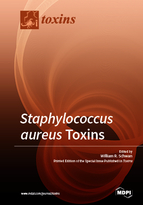Staphylococcus aureus Toxins
A special issue of Toxins (ISSN 2072-6651). This special issue belongs to the section "Bacterial Toxins".
Deadline for manuscript submissions: closed (30 April 2019) | Viewed by 77015
Special Issue Editor
Interests: drug discovery; anti-staphylococcal drugs; bacterial pathogenesis; two-component systems; uropathogenic Escherichia coli
Special Issues, Collections and Topics in MDPI journals
Special Issue Information
Dear Colleagues,
Staphylococcus aureus toxins have a significant role to play in S. aureus pathogenesis. Toxins cause direct damage to the host and some toxins (e.g., enterotoxins and toxic shock syndrome toxin) and elicit a massive pro-inflammatory response that will contribute to indirect damage to the host. Although we know a lot about these S. aureus toxins, we still have a lot to learn about the molecular pathogenesis of them and how the genes that encode the toxins are regulated. This Special Issue will focus on how the toxins play a role in S. aureus pathogenesis, what regulatory mechanisms affect expression of the toxins, and current research tied to the development of toxoid-based vaccines to prevent S. aureus infections.
Prof. William R. Schwan
Guest Editor
Manuscript Submission Information
Manuscripts should be submitted online at www.mdpi.com by registering and logging in to this website. Once you are registered, click here to go to the submission form. Manuscripts can be submitted until the deadline. All submissions that pass pre-check are peer-reviewed. Accepted papers will be published continuously in the journal (as soon as accepted) and will be listed together on the special issue website. Research articles, review articles as well as short communications are invited. For planned papers, a title and short abstract (about 100 words) can be sent to the Editorial Office for announcement on this website.
Submitted manuscripts should not have been published previously, nor be under consideration for publication elsewhere (except conference proceedings papers). All manuscripts are thoroughly refereed through a double-blind peer-review process. A guide for authors and other relevant information for submission of manuscripts is available on the Instructions for Authors page. Toxins is an international peer-reviewed open access monthly journal published by MDPI.
Please visit the Instructions for Authors page before submitting a manuscript. The Article Processing Charge (APC) for publication in this open access journal is 2700 CHF (Swiss Francs). Submitted papers should be well formatted and use good English. Authors may use MDPI's English editing service prior to publication or during author revisions.
Keywords
- Staphylococcus aureus
- toxin
- regulation
- pathogenesis
- mechanism of action







